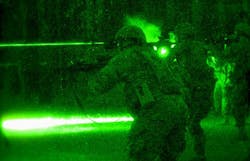DARPA launches WIRED program to develop affordable wafer-scale infrared sensors
These infrared detectors must be able to be fabricated directly on silicon-based readout integrated circuit (ROIC) substrates at the wafer scale.
Officials of the U.S. Defense Advanced Research Projects Agency (DARPA) in Arlington, Va., issued a broad-agency announcement Thursday (DARPA-BAA-15-57) for the Wafer Scale Infrared Detectors (WIRED) program.
DARPA researchers would like the ability to manufacture high-quality miniature SWIR, MWIR, and LWIR detectors as affordably as the industry makes high-quality visible-light digital cameras for cell phones and other small handheld devices.
Infrared focal plane arrays that respond in the SWIR and MWIR spectral bands today are manufactured using complex and time consuming processes that typically involve several manual processing steps, including single-die processes, DARPA researchers explain. The cost of individual cameras is prohibitive for many applications.
Related: Infrared sensors blending with signal processing to yield new levels of surveillance
Cooling MWIR, and LWIR detectors with reasonable power consumption, moreover, typically requires a cryogenic cooler, which adds size, weight, and power consumption, and cost (SWaP-C). SWIR generally doesn't require cryogenic coolers, but focal plane array costs are still high because of complex processing.
SWIR imagers are not widely available with formats greater than 2 megapixels because the size of the die as well as the resulting optics become prohibitively large and expensive.
Fast optics frequently are used for SWIR imaging, and scaling to smaller pixel pitch could enable larger array formats and higher resolution with the same optics. Alternatively, system SWaP could be reduced if the same imager format was achieved with smaller pixels.
The WIRED program focuses on three technical areas: SWIR, MWIR, and LWIR detectors.
SWIR detector research zeroes-in on appropriate materials and wafer-scale processing techniques to produce focal plane arrays with 3-micron pixel pitch without the need for cryogenic cooling or hybrid bump bonding.
Related: Army eyes mast-mounted infrared sensors able to detect and track humans and aerial drones
MWIR detector research concerns materials and wafer-scale processing techniques for 10-micron focal plane arrays without cryogenic cooling or hybrid bump bonding. LWIR work, meanwhile, focuses on 12-micron focal plane arrays without cryogenic cooling or hybrid bump bonding.
The ultimate goal is to develop and demonstrate prototype SWIR, MWIR, and LWIR cameras that can be field tested under controlled conditions. The DARPA WIRED program should be worth as much as $40 million, and several contract awards are expected.
Companies interested should submit abstracts no later than 9 Oct. 2015, and full proposals no later than 23 Nov. 2015 to the DARPA BAA Website at https://baa.darpa.mil.
Email questions or concerns to DARPA's Jay Lewis at DARPA-BAA-1557@ darpa.mil.
More information is online at https://www.fbo.gov/spg/ODA/DARPA/CMO/DARPA-BAA-15-57/listing.html.
